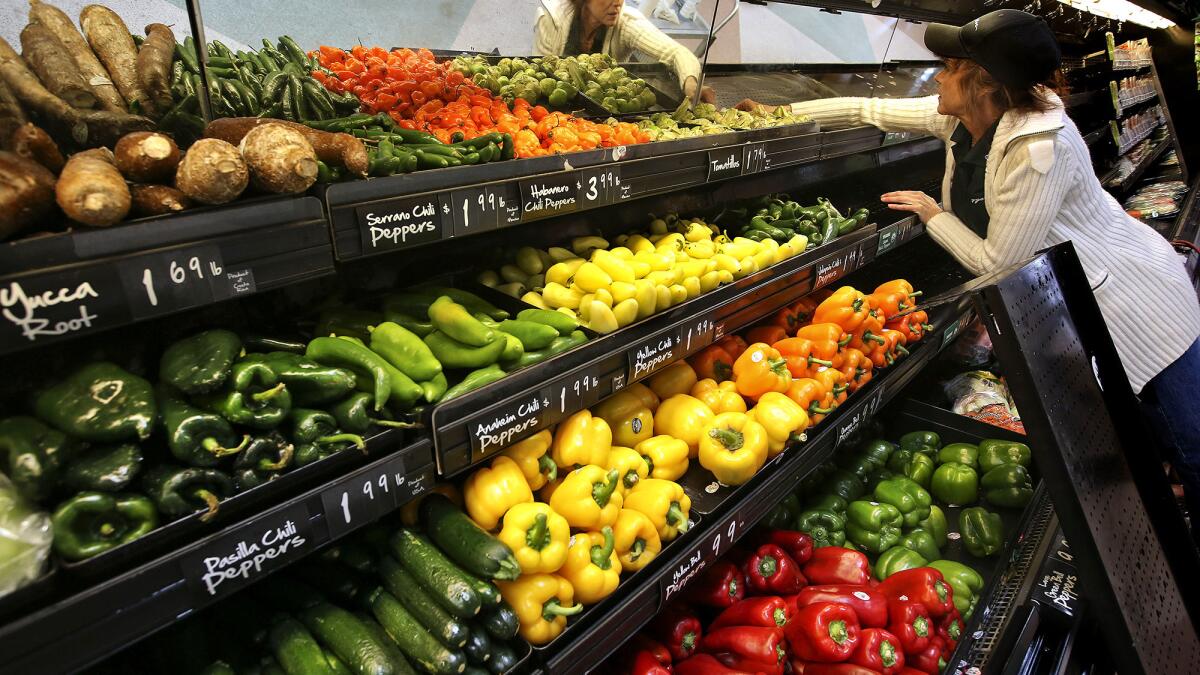Haggen grocery chain begins rollout of new markets in Southland

- Share via
Southern Californians are spoiled when it comes to grocery shopping.
Despite the retrenchment by Fresh & Easy, which is closing 30 Southland stores, the region bristles with food purveyors.
Farmers’ markets and ethnic shops are sprouting in the shadow of stalwarts Ralphs and Albertsons. Smaller chains, including Trader Joe’s, are expanding as Wal-Mart and Target pump up their food offerings. Then there are online players Amazon.com and Google, which are pushing into grocery delivery.
“We are in a world where the really successful chains tend to be more specialized today,” said Jim Prevor, a food analyst and founder of PerishablePundit.com. “It’s Trader Joe’s that has the epicurean concept.... It’s Costco that has the value-in-bulk concept.”
Now there’s a new contender: Haggen Inc., a small Pacific Northwest chain that will soon become a familiar sight in the region.
The Bellingham, Wash., company said in December that it was buying 146 Albertsons, Vons, Pavilions and Safeway stores, including 83 in California, almost all in the south. The Federal Trade Commission ordered Albertsons and Safeway to sell those stores as part of their recent merger.
Haggen (pronounced HAY-ghen) plans to convert its California stores by the end of June. Its first spot opened in Carlsbad two weeks ago.
Bill Shaner, Haggen’s executive in charge of California, Nevada and Arizona operations, acknowledged the competitive pressures ahead. But he said the chain, which operated 18 stores before pouncing on the chance to expand, would distinguish itself as a superior one-stop shop.
Its stores are known for carrying a greater array of organic produce and higher-quality meats and seafood than can be found at a typical supermarket, Shaner said, but with similar prices.
“We are not a Sprouts or Whole Foods or Trader Joe’s. We do carry Tide and Snickers bars and Campbell’s soup,” he said. “That is what sets us apart — our position in the marketplace is somewhere between a current Albertsons or Vons store and Whole Foods.”
Haggen’s marketing will push the idea of hassle-free shopping married with a community feel, said Sara Bamossy, chief strategy officer of Pitch, Haggen’s advertising agency in the Southwest.
The new chain will attract people who are currently “forced to compromise,” she said. “They go to a convenience store moonlighting as a grocery store or specialty stores with their favorite foods but not big brands or is more expensive.”
Haggen’s goal is to swiftly rebrand its new stores, with new signs, shopping carts and in-store software, Shaner said. Each store will be closed for only about 40 hours on average for the initial conversion process, he said, to minimize disruption to shoppers.
“During this process there is a tremendous amount of activity,” said Shaner, who estimates 100 stores in the Southwest will be converted in as many days. “It’s literally a beehive of activity.”
The hectic pace is evident in the desert city of Palmdale, where a former Albertsons supermarket became Haggen’s first beachhead in Los Angeles County. The company started work on the store at midnight Sunday and then reopened 40 hours later on Tuesday at 4 p.m.
On Monday morning, a construction worker in a cherry picker removed the Albertsons sign and installed the Haggen name in cursive script.
Inside, the sound of drilling rang through the air as employees hustled to replace some 30,000 price tags and restock shelves with Haggen-branded merchandise. A worker in a white hard hat rolled a fresh layer of beige paint on the walls.
After its makeover, the 57,000-square-foot store has acquired some of the rustic farmers’ market look that defines Haggen.
Shaner said the most serious remodeling at new Haggen locations will initially take place in the produce department.
In Palmdale, old displays have been switched for stacks of wooden pallets with produce stacked neatly on top. Signs call out locally sourced products, and others spell out the flavor and uses for various fruits (Ambrosia apples, one sign suggests, are “very good” in sauces and “excellent” in pies).
“Customers will see a lot more organic, a lot more natural, what I call ‘healthy for you’ products,” Shaner said.
Haggen will have to work quickly to hold on to current shoppers and woo new ones, analysts said.
The company’s task is extra tricky because Safeway and Albertsons not only have years of detailed customer data on the stores they sold, but also continue to operate supermarkets near many Haggen locations. Other retailers including dollar stores and drugstores will also use the opportunity to poach shoppers.
“There will be unprecedented competition when Haggen opens,” said Burt Flickinger III, managing director of Strategic Resource Group. “There will be localized price wars in the grand opening weeks and months.”
The chain will also need to be careful not to turn off shoppers who were already happy with the assortment before Haggen took over, Prevor said. The next few months will signal whether Haggen’s model finds a home in the Southland.
“Haggen talks about themselves as more upscale than what Safeway used to be. But are these neighborhoods searching for more upscale?” Prevor said.
Shaner said he’s confident that Californians will take a liking to Haggen. To maintain continuity, Haggen has kept existing store employees, expanding its worker base fivefold to 10,000, he said. At the Palmdale store, all former Albertsons employees stayed on, including the manager.
The grocer still has a long way to go. As of Tuesday, only eight of its 83 California stores had opened.
“We are ready to rock and roll,” Shaner said.
Twitter: @ByShanLi
More to Read
Inside the business of entertainment
The Wide Shot brings you news, analysis and insights on everything from streaming wars to production — and what it all means for the future.
You may occasionally receive promotional content from the Los Angeles Times.











